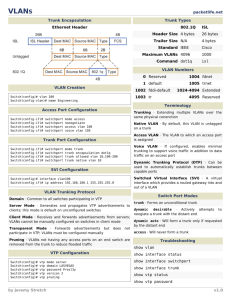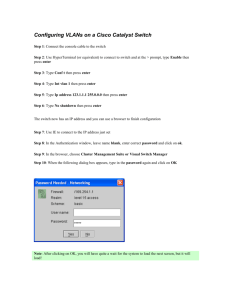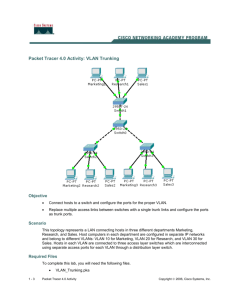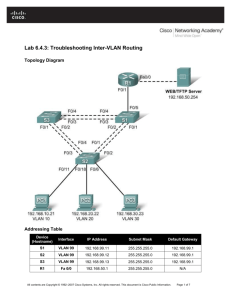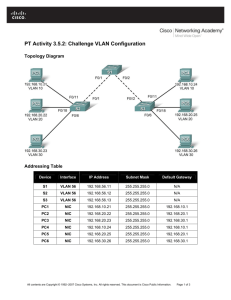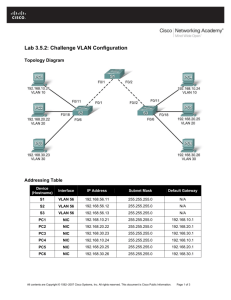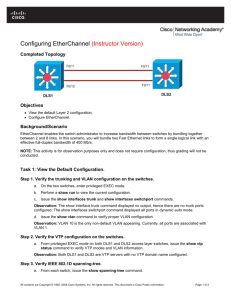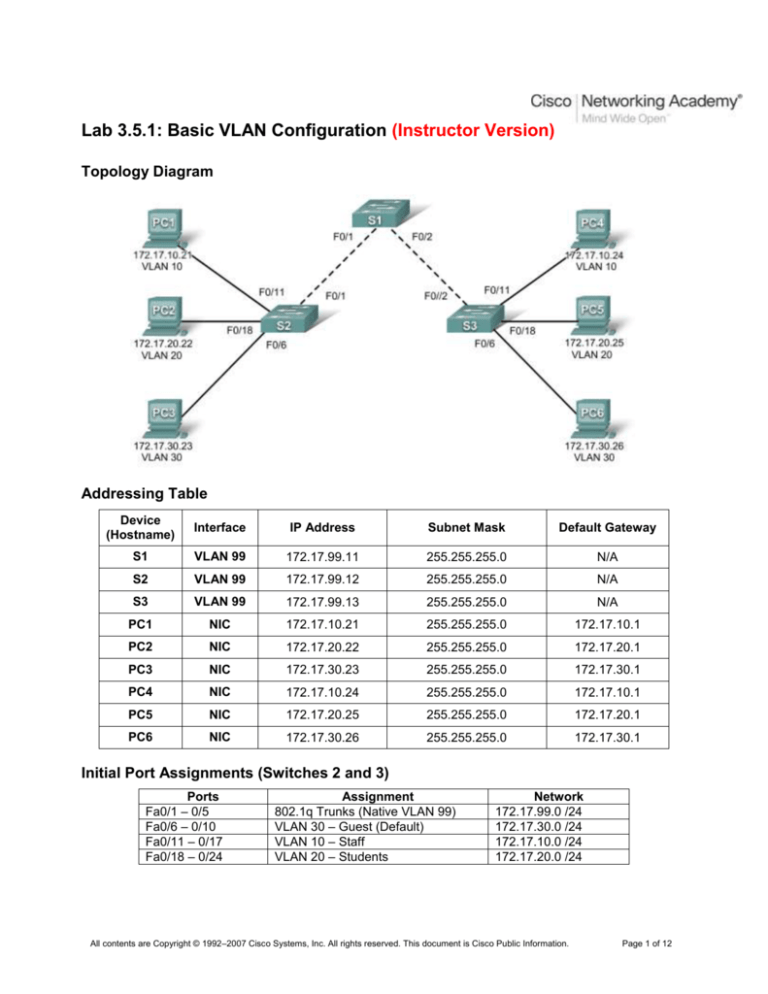
Lab 3.5.1: Basic VLAN Configuration (Instructor Version)
Topology Diagram
Addressing Table
Device
(Hostname)
Interface
IP Address
Subnet Mask
Default Gateway
S1
VLAN 99
172.17.99.11
255.255.255.0
N/A
S2
VLAN 99
172.17.99.12
255.255.255.0
N/A
S3
VLAN 99
172.17.99.13
255.255.255.0
N/A
PC1
NIC
172.17.10.21
255.255.255.0
172.17.10.1
PC2
NIC
172.17.20.22
255.255.255.0
172.17.20.1
PC3
NIC
172.17.30.23
255.255.255.0
172.17.30.1
PC4
NIC
172.17.10.24
255.255.255.0
172.17.10.1
PC5
NIC
172.17.20.25
255.255.255.0
172.17.20.1
PC6
NIC
172.17.30.26
255.255.255.0
172.17.30.1
Initial Port Assignments (Switches 2 and 3)
Ports
Fa0/1 – 0/5
Fa0/6 – 0/10
Fa0/11 – 0/17
Fa0/18 – 0/24
Assignment
802.1q Trunks (Native VLAN 99)
VLAN 30 – Guest (Default)
VLAN 10 – Staff
VLAN 20 – Students
Network
172.17.99.0 /24
172.17.30.0 /24
172.17.10.0 /24
172.17.20.0 /24
All contents are Copyright © 1992–2007 Cisco Systems, Inc. All rights reserved. This document is Cisco Public Information.
Page 1 of 12
CCNA Exploration
LAN Switching and Wireless: VLANs
Lab 3.5.1: Basic VLAN Configuration
Learning Objectives
Perform basic configuration on a switch
Create VLANs
Assign switch ports to a VLAN
Add, move, and change ports
Verify VLAN configuration
Enable trunking on inter-switch connections
Verify trunk configuration
Save the VLAN configuration
Task 1: Prepare the Network
Step 1: Cable a network according to the topology diagram.
Use preferrably the 2960 switch.
If you use 2900 or 2950 switches, the outputs may appear different. Also, certain commands may be
different or unavailable.
Step 2: Clear any existing configurations on the switches, and initialize all ports in the shutdown
state.
Disable any unused ports on the switches:
Switch#config term
Switch(config)#interface range fa0/1-24
Switch(config-if-range)#shutdown
Switch(config-if-range)#interface range gi0/1-2
Switch(config-if-range)#shutdown
Příkaz “interface range” v Packet Tracer vyžaduje mezery kolem pomlčky.
Task 2: Perform Basic Switch Configurations
Step 1: Configure the switches according to the following guidelines.
Configure the switch hostname.
Disable DNS lookup.
Configure an EXEC mode password of class.
Configure a password of cisco for console connections.
Configure a password of cisco for vty connections.
EXEC mode password z cvičných důvodů nastavte, vyzkoušejte a zrušte. Jinak ho budete při práci
nesčetněkrát vyťukávat vždy, když switch automaticky vycouvá z EXEC módu.
Step 2: Re-enable the user ports on S2 and S3.
S2(config)#interface range fa0/6, fa0/11, fa0/18
S2(config-if-range)#switchport mode access
S2(config-if-range)#no shutdown
All contents are Copyright © 1992–2007 Cisco Systems, Inc. All rights reserved. This document is Cisco Public Information.
Page 2 of 12
CCNA Exploration
LAN Switching and Wireless: VLANs
Lab 3.5.1: Basic VLAN Configuration
S3(config)#interface range fa0/6, fa0/11, fa0/18
.................................
Task 3: Configure and Activate Ethernet Interfaces
Step 1: Configure the PCs.
Task 4: Configure VLANs on the Switch
Step 1: Create VLANs on switch S1.
S1(config)#vlan 10
S1(config-vlan)#name
S1(config-vlan)#vlan
S1(config-vlan)#name
S1(config-vlan)#vlan
S1(config-vlan)#name
S1(config-vlan)#vlan
S1(config-vlan)#name
S1(config-vlan)#end
S1#
staff
20
students
30
guest
99
management
Step 2: Verify that the VLANs have been created on S1.
Use the show vlan brief command to verify that the VLANs have been created.
S1#show vlan brief
VLAN Name
Status
Ports
---- ------------------------------- --------- ----------------------------1
default
active
Fa0/1, Fa0/2, Fa0/4, Fa0/5
Fa0/6, Fa0/7, Fa0/8, Fa0/9
Fa0/10, Fa0/11, Fa0/12, Fa0/13
Fa0/14, Fa0/15, Fa0/16, Fa0/17
Fa0/18, Fa0/19, Fa0/20, Fa0/21
Fa0/22, Fa0/23, Fa0/24, Gi0/1
Gi0/2
10
staff
active
20
students
active
30
guest
active
99
management
active
Step 3: Configure and name VLANs on switches S2 and S3.
Create and name VLANs 10, 20, 30, and 99 on S2 and S3 using the commands from Step 1. Verify the
correct configuration with the show vlan brief command.
What ports are currently assigned to the four VLANs you have created?
_______________________________ none
Step 4: Assign switch ports to VLANs on S2 and S3.
The commands are shown for S3 only, but you should configure both S1 and S3 similarly. Save your
configuration when done.
S3(config)#interface range fa0/6-10
S3(config-if-range)#switchport access vlan 30
All contents are Copyright © 1992–2007 Cisco Systems, Inc. All rights reserved. This document is Cisco Public Information.
Page 3 of 12
CCNA Exploration
LAN Switching and Wireless: VLANs
Lab 3.5.1: Basic VLAN Configuration
S3(config-if-range)#interface range fa0/11-17
S3(config-if-range)#switchport access vlan 10
S3(config-if-range)#interface range fa0/18-24
S3(config-if-range)#switchport access vlan 20
S3(config-if-range)#end
S3#copy running-config startup-config
Destination filename [startup-config]? [enter]
Building configuration...
[OK]
Step 5: Determine which ports have been added.
Use the show vlan id vlan-number command on S2 to see which ports are assigned to VLAN 10.
Which ports are assigned to VLAN 10?
_______________________________________________________ Fa0/11, Fa0/12, Fa0/13, Fa0/14,
Fa0/15, Fa0/16, Fa0/17
Note: The show vlan name vlan-name displays the same output.
You can also view VLAN assignment information using the show interfaces interface switchport
command.
Step 6: Assign the management VLAN.
A management VLAN is any VLAN that you configure to access the management capabilities of a switch.
VLAN 1 serves as the management VLAN if you did not specifically define another VLAN. You assign
the management VLAN an IP address and subnet mask.
Because the out-of-the-box configuration of a Cisco switch has VLAN 1 as the default VLAN, VLAN 1 is a
bad choice as the management VLAN: You do not want an arbitrary user who is connecting to a switch to
default to the management VLAN. You configured the management VLAN as VLAN 99 earlier in this lab.
From interface configuration mode, use the ip address command to assign the management IP address
to the switches.
S1(config)#interface vlan 99
S1(config-if)#ip address 172.17.99.11 255.255.255.0
S1(config-if)#no shutdown
S2(config)#interface vlan 99
...................................12 .............
S3(config)#interface vlan 99
...................................13 .............
Assigning a management address allows IP communication between the switches, and also allows any
host connected to a port assigned to VLAN 99 to connect to the switches.
Step 7: Configure trunking and the native VLAN for the trunking ports on all switches.
Trunks are connections between the switches that allow the switches to exchange information for all
VLANS. By default, a trunk port belongs to all VLANs, as opposed to an access port, which can only
belong to a single VLAN.
A native VLAN is assigned to an 802.1Q trunk port. In the topology, the native VLAN is VLAN 99. An
802.1Q trunk port supports traffic coming from many VLANs (tagged traffic) as well as traffic that does not
come from a VLAN (untagged traffic). The 802.1Q trunk port places untagged traffic on the native
VLAN. Untagged traffic is generated by a computer attached to a switch port that is configured with the
native VLAN. One of the reasons for Native VLANs is to maintain backward compatibility with
untagged traffic common to legacy LAN scenarios. It is a best practice to use a VLAN other than
VLAN 1 as the native VLAN.
All contents are Copyright © 1992–2007 Cisco Systems, Inc. All rights reserved. This document is Cisco Public Information.
Page 4 of 12
CCNA Exploration
LAN Switching and Wireless: VLANs
Lab 3.5.1: Basic VLAN Configuration
Use the interface range command in global configuration mode to simplify configuring trunking.
S1(config)#interface range fa0/1-5
S1(config-if-range)#switchport mode trunk
S1(config-if-range)#switchport trunk native vlan 99
S1(config-if-range)#no shutdown
S1(config-if-range)#end
S2(config)# interface range fa0/1-5
...........................................................................................................
S3(config)# interface range fa0/1-5
.............................................................................................................
Verify that the trunks have been configured with the show interface trunk command.
S1#show interface trunk
Port
Fa0/1
Fa0/2
Port
Fa0/1
Fa0/2
Mode
on
on
Encapsulation
802.1q
802.1q
Status
trunking
trunking
Native vlan
99
99
Vlans allowed on trunk
1-4094
1-4094
Port
Fa0/1
Fa0/2
Vlans allowed and active in management domain
1,10,20,30,99
1,10,20,30,99
Port
Fa0/1
Fa0/2
Vlans in spanning tree forwarding state and not pruned
1,10,20,30,99
1,10,20,30,99
Step 8: Verify that the switches can communicate.
From S1, ping the management address on both S2 and S3.
S1#ping 172.17.99.12
S1#ping 172.17.99.13
Step 9: Ping several hosts from PC2.
Ping from host PC2 to host PC1 (172.17.10.21). Is the ping attempt successful? _________ no
Ping from host PC2 to the switch VLAN 99 IP address 172.17.99.12. Is the ping attempt successful?
_________ no
Because these hosts are on different subnets and in different VLANs, they cannot communicate without a
Layer 3 device to route between the separate subnetworks.
Ping from host PC2 to host PC5. Is the ping attempt successful? _________ yes
Because PC2 is in the same VLAN and the same subnet as PC5, the ping is successful
Step 10: Move PC1 (on the port S2 Fast 0/11) into the same VLAN as PC2.
S2#configure terminal
Enter configuration commands, one per line.
S2(config)#interface fastethernet 0/11
S2(config-if)#switchport access vlan 20
End with CNTL/Z.
All contents are Copyright © 1992–2007 Cisco Systems, Inc. All rights reserved. This document is Cisco Public Information.
Page 5 of 12
CCNA Exploration
LAN Switching and Wireless: VLANs
Lab 3.5.1: Basic VLAN Configuration
S2(config-if)#end
Ping from host PC2 to host PC1. Is the ping attempt successful? _________ no
Even though the ports used by PC1 and PC2 are in the same VLAN, they are still in different
subnetworks, so they cannot communicate directly.
Step 11: Change the IP address and network on PC1.
Change the IP address on PC1 to 172.17.20.22. The subnet mask and default gateway can remain the
same. Once again, ping from host PC2 to host PC1, using the newly assigned IP address.
Is the ping attempt successful? _________yes
Why was this attempt successful?
____________________________________________________________________________________
____________________________________________________________________________________
Hosts must be in the same VLAN and in the same subnet to communicate directly through the switches.
All contents are Copyright © 1992–2007 Cisco Systems, Inc. All rights reserved. This document is Cisco Public Information.
Page 6 of 12
CCNA Exploration
LAN Switching and Wireless: VLANs
Lab 3.5.1: Basic VLAN Configuration
Final Switch Configurations
S1
hostname S1
!
enable secret class
no ip domain-lookup
!
interface FastEthernet0/1
switchport trunk native vlan 99
switchport mode trunk
!
interface FastEthernet0/2
switchport trunk native vlan 99
switchport mode trunk
!
interface FastEthernet0/3
switchport trunk native vlan 99
switchport mode trunk
!
interface FastEthernet0/4
switchport trunk native vlan 99
switchport mode trunk
!
interface FastEthernet0/5
switchport trunk native vlan 99
switchport mode trunk
!
interface FastEthernet0/6
shutdown
!
<all remaining FastEthernet and GigabitEthernet interface are shutdown>
!
interface Vlan1
no ip address
no ip route-cache
!
interface Vlan99
ip address 172.17.99.11 255.255.255.0
no ip route-cache
!
line con 0
exec-timeout 0 0
password cisco
logging synchronous
login
line vty 0 4
exec-timeout 0 0
password cisco
logging synchronous
login
line vty 5 15
exec-timeout 0 0
password cisco
logging synchronous
login
All contents are Copyright © 1992–2007 Cisco Systems, Inc. All rights reserved. This document is Cisco Public Information.
Page 7 of 12
CCNA Exploration
LAN Switching and Wireless: VLANs
Lab 3.5.1: Basic VLAN Configuration
!
end
S2
hostname S2
!
enable secret class
no ip domain-lookup
!
interface FastEthernet0/1
switchport trunk native vlan
switchport mode trunk
!
interface FastEthernet0/2
switchport trunk native vlan
switchport mode trunk
!
interface FastEthernet0/3
switchport trunk native vlan
switchport mode trunk
!
interface FastEthernet0/4
switchport trunk native vlan
switchport mode trunk
!
interface FastEthernet0/5
switchport trunk native vlan
switchport mode trunk
!
interface FastEthernet0/6
switchport access vlan 30
switchport mode access
!
interface FastEthernet0/7
switchport access vlan 30
switchport mode access
shutdown
!
interface FastEthernet0/8
switchport access vlan 30
switchport mode access
shutdown
!
interface FastEthernet0/9
switchport access vlan 30
switchport mode access
shutdown
!
interface FastEthernet0/10
switchport access vlan 30
switchport mode access
shutdown
!
interface FastEthernet0/11
switchport access vlan 20
99
99
99
99
99
All contents are Copyright © 1992–2007 Cisco Systems, Inc. All rights reserved. This document is Cisco Public Information.
Page 8 of 12
CCNA Exploration
LAN Switching and Wireless: VLANs
Lab 3.5.1: Basic VLAN Configuration
switchport mode access
!
interface FastEthernet0/12
switchport access vlan 10
switchport mode access
shutdown
!
interface FastEthernet0/13
switchport access vlan 10
switchport mode access
shutdown
!
interface FastEthernet0/14
switchport access vlan 10
switchport mode access
shutdown
!
interface FastEthernet0/15
switchport access vlan 10
switchport mode access
shutdown
!
interface FastEthernet0/16
switchport access vlan 10
switchport mode access
shutdown
!
interface FastEthernet0/17
switchport access vlan 10
switchport mode access
shutdown
!
interface FastEthernet0/18
switchport access vlan 20
switchport mode access
!
interface FastEthernet0/19
switchport access vlan 20
switchport mode access
shutdown
!
interface FastEthernet0/20
switchport access vlan 20
switchport mode access
shutdown
!
interface FastEthernet0/21
switchport access vlan 20
switchport mode access
shutdown
!
interface FastEthernet0/22
switchport access vlan 20
switchport mode access
shutdown
!
All contents are Copyright © 1992–2007 Cisco Systems, Inc. All rights reserved. This document is Cisco Public Information.
Page 9 of 12
CCNA Exploration
LAN Switching and Wireless: VLANs
Lab 3.5.1: Basic VLAN Configuration
interface FastEthernet0/23
switchport access vlan 20
switchport mode access
shutdown
!
interface FastEthernet0/24
switchport access vlan 20
switchport mode access
shutdown
!
interface GigabitEthernet0/1
shutdown
!
interface GigabitEthernet0/2
shutdown
!
interface Vlan1
no ip address
no ip route-cache
shutdown
!
interface Vlan99
ip address 172.17.99.12 255.255.255.0
no ip route-cache
!
ip http server
!
control-plane
!
!
line con 0
exec-timeout 0 0
password cisco
logging synchronous
login
line vty 0 4
exec-timeout 0 0
password cisco
logging synchronous
login
line vty 5 15
exec-timeout 0 0
password cisco
logging synchronous
login
!
!
end
S3
hostname S3
no ip domain-lookup
enable secret class
!
interface FastEthernet0/1
All contents are Copyright © 1992–2007 Cisco Systems, Inc. All rights reserved. This document is Cisco Public Information.
Page 10 of 12
CCNA Exploration
LAN Switching and Wireless: VLANs
Lab 3.5.1: Basic VLAN Configuration
switchport trunk native vlan 99
switchport mode trunk
!
interface FastEthernet0/2
switchport trunk native vlan
switchport mode trunk
!
interface FastEthernet0/3
switchport trunk native vlan
switchport mode trunk
!
interface FastEthernet0/4
switchport trunk native vlan
switchport mode trunk
!
interface FastEthernet0/5
switchport trunk native vlan
switchport mode trunk
!
interface FastEthernet0/6
switchport access vlan 30
switchport mode access
!
interface FastEthernet0/7
switchport access vlan 30
!
interface FastEthernet0/8
switchport access vlan 30
!
interface FastEthernet0/9
switchport access vlan 30
!
interface FastEthernet0/10
switchport access vlan 30
!
interface FastEthernet0/11
switchport access vlan 10
switchport mode access
!
interface FastEthernet0/12
switchport access vlan 10
!
interface FastEthernet0/13
switchport access vlan 10
!
interface FastEthernet0/14
switchport access vlan 10
!
interface FastEthernet0/15
switchport access vlan 10
!
interface FastEthernet0/16
switchport access vlan 10
!
interface FastEthernet0/17
switchport access vlan 10
99
99
99
99
All contents are Copyright © 1992–2007 Cisco Systems, Inc. All rights reserved. This document is Cisco Public Information.
Page 11 of 12
CCNA Exploration
LAN Switching and Wireless: VLANs
Lab 3.5.1: Basic VLAN Configuration
!
interface FastEthernet0/18
switchport access vlan 20
switchport mode access
!
interface FastEthernet0/19
switchport access vlan 20
!
interface FastEthernet0/20
switchport access vlan 20
!
interface FastEthernet0/21
switchport access vlan 20
!
interface FastEthernet0/22
switchport access vlan 20
!
interface FastEthernet0/23
switchport access vlan 20
!
interface FastEthernet0/24
switchport access vlan 20
!
interface GigabitEthernet0/1
!
interface GigabitEthernet0/2
!
interface Vlan1
no ip address
no ip route-cache
shutdown
!
interface Vlan99
ip address 172.17.99.13 255.255.255.0
no ip route-cache
!
line con 0
password cisco
login
line vty 0 4
password cisco
login
line vty 5 15
password cisco
login
!
end
All contents are Copyright © 1992–2007 Cisco Systems, Inc. All rights reserved. This document is Cisco Public Information.
Page 12 of 12


